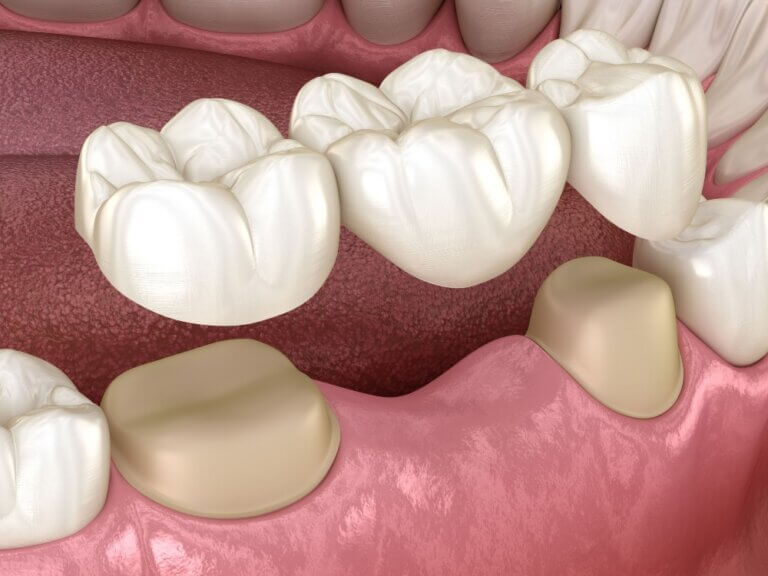Dental Bridge Open Margin

What Is A Dental Bridge Open Margin?
A dental bridge open margin refers to a small gap between the bridge and the supporting teeth (abutments). Ideally, the bridge should fit snugly against the teeth to create a continuous, smooth surface that prevents bacteria and food from getting trapped. An open margin can develop if the bridge doesn’t fit properly or due to poor cementation. Often, this gap is not visible to the naked eye and may only be detected through a dental X-ray. If left untreated, the open margin can lead to several oral health problems, including tooth decay, gum disease, dental pain, and even tooth loss. Therefore, it’s essential to identify and address the issue promptly.
Before you contact a Toronto dentist to examine a Dental Bridge Open Margin, there are some things you should know as a patient:
- Why Do I Have A Dental Bridge Open Margin?
- Signs And Symptoms Of A Dental Bridge Open Margin
- Treatment Options For A Dental Bridge Open Margin
- Managing A Dental Bridge Open Margin Until You Can See The Dentist
- Frequently Asked Questions About Dental Bridge Open Margins
If you have questions about a Dental Bridge Open Margin or other dental problems, please contact us for more information.
Why Do I Have A Dental Bridge Open Margin?
There are several reasons why an open margin might occur:
- Poor Bridge Design: If the dental lab doesn’t design the bridge with precision, the margins of the bridge might not align properly with the tooth. Physical impressions can also introduce inaccuracies if the impression material is compromised by moisture or excess gum tissue.
- Improper Bridge Placement: The cementation of the dental bridge is a technique-sensitive procedure. If the bridge isn’t seated fully or is placed too high, it can result in a gap between the bridge and the tooth.
It’s crucial to address an open margin promptly to avoid complications such as tooth decay, gum disease, and potential tooth loss. If you have further questions about Open Margins under a Dental Bridge, please contact us.
Signs and Symptoms of A Dental Bridge Open Margin
If you suspect an open margin under your dental bridge, you may experience the following symptoms:
- Tooth Sensitivity: Sensitivity to hot or cold foods and drinks is common with an open margin.
- Pain or Discomfort: You may feel pain when chewing or biting down, especially on the affected side.
- Gum Swelling: Tender or swollen gums around the bridge could indicate a problem.
- Food Trapping: You may notice that food frequently gets stuck in the area, requiring more frequent flossing.
- Visible Gap: If you can feel or see a small space between the bridge and the tooth, this may be a sign of an open margin.
- Discoloration: Dark spots or grayish discoloration under the bridge may signal tooth decay or infection.
- High Bridge: If the bridge feels higher than your other teeth when biting down, this may indicate improper seating.
If you notice any of these symptoms, contact your dentist as soon as possible for an evaluation. If you have further questions about signs and symptoms of a Dental Bridge Open Margin, please contact us.
Treatment Options for A Dental Bridge Open Margin
Once your dentist identifies an open margin, they may recommend one of the following treatment options:
- Refitting the Bridge: If the bridge is otherwise intact, your dentist might be able to remove it, clean the area, and re-cement it properly.
- Replacing the Bridge: If the bridge is damaged or too ill-fitting, your dentist may suggest fabricating a new one to ensure a proper fit.
Addressing the issue promptly is key to preventing further damage to the underlying tooth structure. If you have further questions about treatment options for a Dental Bridge Open Margin, please contact us.

Managing A Dental Bridge Open Margin Until You Can See the Dentist
If you have an open margin and cannot see your dentist immediately, follow these steps to manage the issue:
- Maintain Good Oral Hygiene: Gently brush and floss around the bridge to keep the area clean and minimize the risk of tooth decay or infection. Rinse with salt water or an antiseptic mouthwash to reduce inflammation.
- Use Pain Relievers: Over-the-counter medications like ibuprofen (Advil) or acetaminophen (Tylenol) can help alleviate pain or sensitivity.
- Avoid Chewing on the Affected Side: To prevent further irritation or damage, avoid chewing on the side with the open margin.
While these measures can provide temporary relief, it’s important to schedule an appointment with your dentist as soon as possible to address the underlying issue. If you have further questions about how to manage and treat a Dental Bridge Open Margin, please contact us.
Frequently Asked Questions About Dental Bridge Open Margins
- What complications can arise from an open margin?
If left untreated, open margins can lead to tooth decay, gum disease, dental pain, and even tooth loss.
- How are open margins diagnosed?
Dentists diagnose open margins through clinical examinations and dental X-rays to detect gaps not visible to the naked eye.
- Can an open margin be repaired without replacing the dental bridge?
In some cases, minor open margins can be repaired with dental bonding or cement. However, significant gaps usually require replacing the bridge to ensure a proper fit and prevent further complications.
- Will insurance cover the cost of replacing a dental bridge with an open margin?
Coverage varies by insurance plan; consult your provider to determine if replacement is covered.
Addressing open margins in dental bridges is crucial to maintaining oral health and preventing potential complications. If you have further questions about how to manage and treat a Dental Bridge Open Margin, please contact us.

